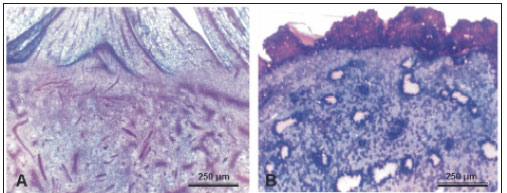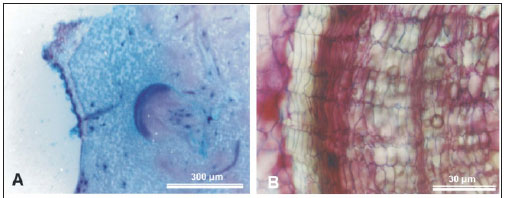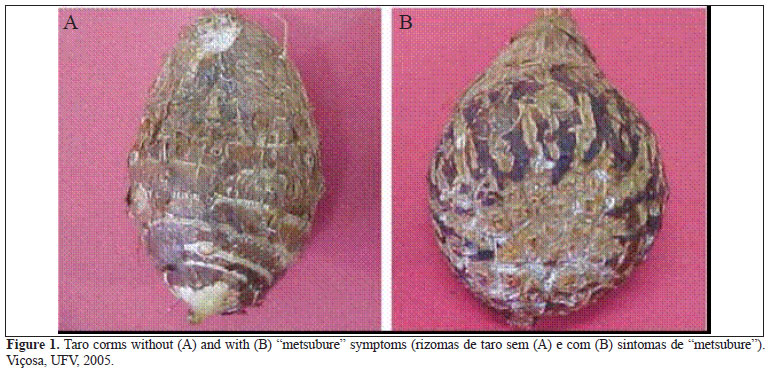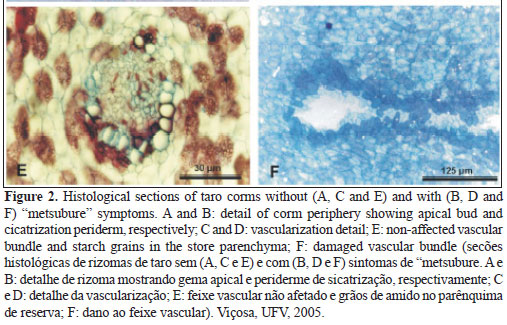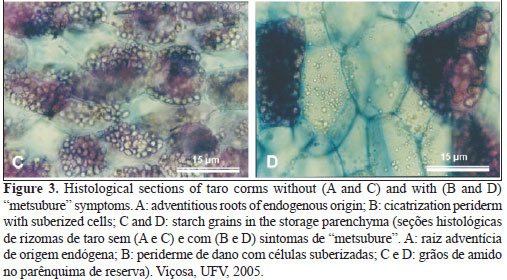Abstracts
Taro plants present high Ca absorption. There is evidence that the disorder "metsubure" is of nutritional origin being attributed to calcium deficiency. The metsubure is characterized by the corm apical bud suppression and a smooth lesion in the apex. This disorder reduces the taro corms value as food and hinders their utilization as a propagative material in commercial fields. In subterranean structures, Ca deficiency is believed to be more harmful to the vascular tissue cells since they have thicker walls than other tissue cells. Thus, this work aimed to characterize the anatomical changes in taro corms (Colocasia esculenta), cv. Chinese (BGH 5928) with "metsubure" symptoms. For this, corms with and without this symptom were obtained from plants grown in a greenhouse, in pots, containing soil. Corms presenting "metsubure" showed anatomical changes with damage in the vascular system which led to the suppression of apical bud formation, with detection of a wound periderm. In these corms, the periderm was thicker with compact and suberized cell layers; moreover parenchyma cells were larger with less starch accumulation as compared to corms without "metsubure" symptoms.
Colocasia esculenta; mineral nutrition; physiological disorder; eddoe
Plantas de taro apresentam grande absorção de cálcio. Evidências levam a supor que o distúrbio "metsubure" seja de origem nutricional atribuído principalmente à deficiência de Ca. O metsubure é caracterizado pela supressão da gema apical dos rizomas-filho, os quais ficam com o topo achatado ou côncavo. Esta desordem desvaloriza o produto comercialmente e inviabiliza a utilização desses rizomas como material propagativo em cultivos comerciais. Em estruturas subterrâneas acredita-se que a deficiência de Ca seja mais prejudicial às células que compõem o tecido condutor em razão das mesmas apresentarem paredes celulares mais espessas do que as células que compõem os demais tecidos. O trabalho teve como objetivo caracterizar as alterações anatômicas em rizomas de taro (Colocasia esculenta), cv. Chinês (BGH 5928) com sintomas de "metsubure". Para isso, rizomas com presença ou ausência do sintomas "metsubure" foram obtidos de plantas cultivadas em casa de vegetação, em vasos preenchidos com solo. Rizomas com sintomas de "metsubure" apresentaram alterações anatômicas com danos no sistema vascular que levaram à supressão da formação da gema apical com detecção da periderme de dano. Nestes rizomas, a periderme de dano formada foi mais espessa, com camadas de células compactas e suberizadas; além disto, as células do parênquima foram maiores e apresentavam menor acúmulo de amido em comparação com os rizomas sem sintomas de "metsubure".
Colocasia esculenta; nutrição mineral; desordem fisiológica; inhame
SCIENTIFIC COMMUNICATION COMUNICAÇÃO CIENTÍFICA
Anatomical alterations in taro corms with "metsubure" symptoms
Alterações anatômicas em rizomas de taro com sintomas de "metsubure"
Francisco HF PereiraI; Mário PuiattiII; Renata MSA MeiraII; Paulo CR FontesII
IUFCG-CCTA, R. João Leite 517, Centro, 58840-000 Pombal-PB; fhfpereira@ccta.ufcg.edu.br
IIUFV, 36570-000 Viçosa-MG; mpuiatti@ufv.br; pacerefo@ufv.br; meira@ufv.br
ABSTRACT
Taro plants present high Ca absorption. There is evidence that the disorder "metsubure" is of nutritional origin being attributed to calcium deficiency. The metsubure is characterized by the corm apical bud suppression and a smooth lesion in the apex. This disorder reduces the taro corms value as food and hinders their utilization as a propagative material in commercial fields. In subterranean structures, Ca deficiency is believed to be more harmful to the vascular tissue cells since they have thicker walls than other tissue cells. Thus, this work aimed to characterize the anatomical changes in taro corms (Colocasia esculenta), cv. Chinese (BGH 5928) with "metsubure" symptoms. For this, corms with and without this symptom were obtained from plants grown in a greenhouse, in pots, containing soil. Corms presenting "metsubure" showed anatomical changes with damage in the vascular system which led to the suppression of apical bud formation, with detection of a wound periderm. In these corms, the periderm was thicker with compact and suberized cell layers; moreover parenchyma cells were larger with less starch accumulation as compared to corms without "metsubure" symptoms.
Keywords: Colocasia esculenta, mineral nutrition, physiological disorder, eddoe.
RESUMO
Plantas de taro apresentam grande absorção de cálcio. Evidências levam a supor que o distúrbio "metsubure" seja de origem nutricional atribuído principalmente à deficiência de Ca. O metsubure é caracterizado pela supressão da gema apical dos rizomas-filho, os quais ficam com o topo achatado ou côncavo. Esta desordem desvaloriza o produto comercialmente e inviabiliza a utilização desses rizomas como material propagativo em cultivos comerciais. Em estruturas subterrâneas acredita-se que a deficiência de Ca seja mais prejudicial às células que compõem o tecido condutor em razão das mesmas apresentarem paredes celulares mais espessas do que as células que compõem os demais tecidos. O trabalho teve como objetivo caracterizar as alterações anatômicas em rizomas de taro (Colocasia esculenta), cv. Chinês (BGH 5928) com sintomas de "metsubure". Para isso, rizomas com presença ou ausência do sintomas "metsubure" foram obtidos de plantas cultivadas em casa de vegetação, em vasos preenchidos com solo. Rizomas com sintomas de "metsubure" apresentaram alterações anatômicas com danos no sistema vascular que levaram à supressão da formação da gema apical com detecção da periderme de dano. Nestes rizomas, a periderme de dano formada foi mais espessa, com camadas de células compactas e suberizadas; além disto, as células do parênquima foram maiores e apresentavam menor acúmulo de amido em comparação com os rizomas sem sintomas de "metsubure".
Palavras-chave: Colocasia esculenta, nutrição mineral, desordem fisiológica, inhame.
Taro (Colocasia esculenta) is the major food plant of the Araceae family, characterized by corms rich in carbohydrates, especially starch. In Brazil, it is most cultivated in the central-southern region, mainly in Minas Gerais, Rio de Janeiro and Espírito Santo states (Puiatti, 2002). A large amount of taro corms with "metsubure" symptoms has been verified in the last years in Brazil (Carmo & Bárbara, 2002).
"Metsubure" is a physiological disorder, characterized by the growth suppression of the corm apical bud (Tanabe et al., 1980; Tanabe & Ikeda, 1980). This abnormality leads to 70% of reduction in the marketable corm yield in Espírito Santo state (Carmo & Bárbara, 2002). "Metsubure" reduces the taro corms values as food and hinders their utilization as a propagative material in commercial fields (Tanabe & Ikeda, 1980; Tanabe et al., 1980; Carmo & Bárbara, 2002; Puiatti, 2002).
The term "metsubure" was proposed in the 1970s in Japan (Tanabe et al., 1980). Due to the apical bud absence in the cormels (secondary-corms), the product is neither suitable for human consumption nor as propagative material in commercial cultivations (Tanabe & Ikeda, 1980; Tanabe et al., 1980; Puiatti, 2002; Carmo & Bárbara, 2002). "Metsubure" has been the cause of great concern among commercial producers in the state of Espírito Santo, Brazil, for reducing the marketable corms yield up to 70% (Carmo & Bárbara, 2002). Studies carried out by Tanabe & Ikeda (1980) using nutritive solution and in the field with organic material (Tanabe et al., 1980; Tanabe & Ikeda, 1980) and in pots by Pereira et al. (2006), showed evidences that led these authors to assume that "metsubure" had a nutritional origin attributed to Ca deficiency.
Taro plants present high Ca absorption (Puiatti et al., 1992) and there is evidence that "metsubure" is attributed to Ca and nutrition (Tanabe et al., 1980; Tanabe & Ikeda, 1980; Pereira et al., 2006). Usually, fungi, bacteria and nematode presence is not detected in corms with "metsubure" symptoms (Carmo & Bárbara, 2002). Physiological disorders, similar to "metsubure", attributed to Ca deficiency, have been verified in potato sprouts and tomato fruits. In potato sprouts, Ca deficiency causes sub-apical necrosis (Dyson & Digby, 1975; Seling et al., 2000), which is initially characterized by dark vascular tissues and later, apical meristem death (Seling et al., 2000). Ca deficiency in these tissues is first detected in the membrane and cellular wall, reducing the cells stability and integrity (Taiz & Zeiger, 2004).
In tomato plants, Ca deficiency causes fruit blossom-end rot (Adams & Ho, 1993; Minamide & Ho, 1993). According to Ho et al. (1993), blossom-end rot, characterized by a necrotic tissue on the distal portion of the fruit, is partly due to inadequate xylem development, especially in the distal portion of the fruit. Thus, Ca deficiency causes structural changes in the tissues, especially the vascular ones. This seems to hinder photo assimilates and mineral nutrients access to the plant growing points, such as sprouts and distal portion of the fruit, leading to necrosis of these tissues. In subterranean structures, Ca deficiency is believed to be more harmful to the vascular tissue cells since they have thicker walls than other tissue cells (Seling et al., 2000).
Some anatomical studies have been carried out on taro corms (Harris et al., 1992) but they only describe the tissue organization without taking into account structural changes due to physiological disorders, as "metsubure". The objective of this paper was to characterize anatomical changes occurring in taro corms with "metsubure" in order to identify standard symptoms which will contribute to a rapid and efficient "metsubure" diagnostic.
MATERIAL AND METHODS
To obtain corms with and without "metsubure" symptoms, taro plants were cultivated under greenhouse conditions at the Universidade Federal de Viçosa from September 28, 2004 to June 28, 2005. The plants were grown in a low fertility Argissolo Vermelho Amarelo Câmbico (Ultisol) soil, pH (H2O)= 5.0; K= 20 and P= 0.8 mg dm-3; Ca2+= 0.2, Mg2+= 0.2, Al3+= 0.5 and H + Al= 3.0 cmolc dm-3. After sieved and fertilized with macro and micronutrients (Pereira et al., 2006), half of the soil was fertilized with CaCl2 at 232 mg dm-3 of Ca and put in 10 L pots. The remained soil was also put in 10 L pots without Ca fertilization. Cormels of Chinise clone (BGH 5928) with 25 g fresh weight were planted in the pots.
Nine months after planting, with the shoot totally dried, the plants were harvested and the cormels (secondary-corms) were visually evaluated for "metsubure" presence. Three corms with and without "metsubure" symptoms, replicated four times, were anatomically characterized in a laboratory of the Universidade Federal de Viçosa. For this, a 1.0 cm2 sample was removed from the apex of corms with and without "metsubure" symptoms. The samples were freshly cut (longitudinal sections) with a manual microtome progressively from the least to the most affected tissue. The cuts were placed in sodium hypochlorite at 70% for 30 min for tissue clarification, washed and stained with safranin alcoholic solution and astra blue (Gerlach, 1984). Temporary slides were mounted with glycerin diluted in water (60%). Tissues analysis and photographic documentation were accomplished using an Olympus AX70 microscope equipped with a U-Photo photographic system and digital camera (Diagnostic Instruments Work, model Camera Spot Insight).
RESULTS AND DISCUSSION
Corms without and with "metsubure" symptoms are shown (Figure 1). A well-formed apical bud was observed in corms without "metsubure" (Figure 1A) but not in corms with symptoms (Figure 1B). "Metsubure" is a disorder characterized by the corm apical bud suppression and a smooth lesion in the apex. The affected region is of varied size, normally circular in shape, and slightly brownish.
Corms without "metsubure" symptoms presented a thick periderm, with suberized cells arranged in compact radial layers; the cortex is not well-delimited, being only constituted by a storage parenchyma with thin-walled cells; the xylem display lignified and thick cellular walls and no collenchyma or sclerenchyma tissues were identified (Figures 2E and 3A). Although in a small amount, vascular bundles occur both near and in the central portion of the organ (Figures 2A and 2C). Also, in corms without "metsubure" a well-formed bud, vascularized tissue and primordium of leaf were observed (Figure 2A) and roots (Figure 3A).
In corms with "metsubure", lacked the apical bud formation. There was a necrotic cicatrization tissue formation or wounding periderm, highly suberized cells, and damaged vascular bundles near the necrotic area (Figure 2B). The formation of compact and highly suberized cell layers was also observed (Figure 3B). Such behavior is reinforced by the changes verified in the vascular bundles, when comparing corms with and without "metsubure" symptoms (Figures 2C, D, E and F).
Absence of early root formation in corm tissues without "metsubure" symptoms was also verified (Figure 3B), stressing the lack of vascularized tissues. The vascular system restriction in taro corms may have limited the distribution of water and assimilates to the apical meristem, as verified in potato (Seling et al., 2000) and tomato (Ho et al., 1993), leading to cell death and subsequent tissue necrosis in the apical portion of the corms.
The parenchyma cells were smaller and with more starch grains in the corms (Figure 3C) than in the corms with "metsubure" symptoms (Figure 3D). Such behavior suggests that under Ca deficiency, cellular division and starch accumulation are restricted.
In the present study "metsubure" incidence was verified only in corms of plants not fertilized with Ca. Corms with "metsubure" symptoms showed low Ca and high K contents, showing that the occurrence of "metsubure" disorder was due to limited Ca availability in the corm tissues (Pereira et al., 2006). Taro plants have a high Ca absorption but due to its high leaf area and Ca moving mainly via the xylem, most of the absorbed Ca goes to the leaves via the transpiratory flow (Puiatti et al., 1992). Ca is required in cellular elongation and division processes, being essential in promoting cellular membrane stability (Marschner, 1995; Taiz & Zeiger, 2004). Under Ca deficiency, membrane and cellular walls lose integrity, leading to cell death, and ultimately necrosis and suppression of the apical bud and appearance of "metsubure" symptoms.
Corms without "metsubure" symptoms presented thick periderm, suberized cells arranged in compact radial layers; non-delimited cortex, only constituted by storage parenchyma with thin-walled cells and xylem with lignified and thick cellular walls as were also reported in the literature (Harris et al., 1992). Absence of collenchyma and sclerenchyma tissues were also verified in taro corms. In addition, in the corm without "metsubure", a vascularized and well-formed bud with leaf and root primordia was observed.
In the corm with "metsubure", there was apical bud growth suppression and a necrotic healing tissue or wounding periderm formation with highly suberized cells and damaged vascular bundles near the necrotic area. In an analogy to potato plants (Seling et al., 2000), it is believed that under Ca deficiency there is apical bud formation but as a result of the processes of irregular cellular division and expansion, membranes and cellular walls would lose their integrity and stability, leading to cellular liquid overflowing death of cells, necrosis and growth suppression of the apical bud.
The formation of packed and highly suberized cell layers was also observed, likely with the purpose of regenerating the necrotic tissue and protecting the corm from microorganism attack and excessive water loss. Such response may be reinforced by changes observed in the vascular bundles, when comparing corms with and without "metsubure" symptoms, showing the occurrence of damage to the vascular system.
In taro corms with the physiological disorder, the damaged periderm was thicker with compact and highly suberized cell layers. Similar anatomic changes to those verified in the damaged cells have been found on mechanically-damaged potatoes (Burton et al., 1992).
Anatomical evaluation is a useful and fast tool to diagnose "metsubure" in taro corms. The most evident "metsubure" symptoms are: (1) damage in the stem and root buds inducing the formation of a wound periderm; (2) induction of modification in the vascular bundle organization, especially in xylem and phloem cells; (3) impairment organization of reserve parenchyma cells, which are small and with low starch grain contents; (4) thickening of the periderm.
(Received on May 2, 2011; accepted on August, 17, 2012)
- ADAMS P; HO LC. 1993. Effects of environment on the uptake and distribution of calcium in tomato and on the incidence of blossom-end rot. Plant Soil 154:127-132.
- BURTON WG; VAN ES A; HARTMANS KJ. 1992. The physics and physiology of storage. In: HARRIS P (ed). The potato crop London: Chapman & Hall. p. 608-727.
- CARMO CAS; BÁRBARA WPF. 2002. Pesquisas com a cultura do taro no Estado do Espírito Santo. In: CARMO CAS (ed). Inhame e taro: sistemas de produção familiar Vitória: Incaper. p. 155-165.
- DYSON PW; DIGBY J. 1975. Effect of calcium on sprout growth and sub-apical necrosis in Majestic potatoes. Potato Research 18:290-305.
- GERLACH D. 1984. Botanische Mikrotechnik Stuttgart: Georg Thieme Verlag. 311p.
- HARRIS PJ; FERGUSON LR; ROBERTON AM; MCKENZIE RJ; WHITE JB. 1992. Cell-wall histochemistry and anatomy of taro (Colocasia esculenta). Australian Journal of Botany 40:207-222.
- HO LC; BELDA R; BROWN M; ANDREWS J; ADAMS P. 1993. Uptake and transport of calcium and the possible causes of blossom-end rot in tomato. Journal of Experimental Botany 44:509-518.
- MARSCHNER H. 1995. Mineral nutrition of higher plants London: Academic Press. 889p.
- MINAMI RT; HO LC. 1993. Deposition of calcium compounds in tomato fruit in relation to calcium transport. Journal of Horticultural Science 68:755-762.
- PEREIRA FHF; PUIATTI M; FONTES PCR; AQUINO LA. 2006. Produção de biomassa e rizomas e incidência de "Metsubure" em taro submetido a doses de potássio com e sem cálcio. Horticultura Brasileira 24: 17-21.
- PUIATTI M. 2002. Manejo da cultura do taro. In: CARMO CAS (ed). Inhame e taro: sistema de produção familiar Vitória:Incaper. p. 203-252.
- PUIATTI M; GREENMAN S; KATSUMOTO R; FÁVERO C. 1992. Crescimento e absorção de macronutrientes pelo inhame 'Chinês' e 'Japonês'. Horticultura Brasileira 10:89-92.
- SELING S; WISSEMEIER AH; CAMBIER P; CUTSEM PV. 2000. Calcium deficiency in potato (Solanum tuberosum ssp. tuberosum) leaves and its effects on the pectic composition of the apoplastic fluid. Physiologia Plantarum 109:44-50.
- TAIZ L; ZEIGER E. 2004. Plant physiology, 2nd ed. Sunderland, Massachusetts: Sinauer Associates, Inc., Publishers. 792p.
- TANABE I; IKEDA K. 1980. On "metsubure" symptomss of taro corms. II The effects of potassium application on the "metsubure" corm formation of taro. Soil Science and Plant Nutrition 26:461-468.
- TANABE I; KITAYAMA T; IKEDA K. 1980. On "metsubure" symptomss of taro corms. I. Verification of the induction of "metsubure" symptoms by calcium deficiency in water culture. Soil Science and Plant Nutrition 26:343-351.
Publication Dates
-
Publication in this collection
07 Jan 2013 -
Date of issue
Dec 2012
History
-
Received
02 May 2011 -
Accepted
17 Aug 2012

